Apple Announces M2 SoC: Apple Silicon for Macs Updated For 2022
by Ryan Smith on June 6, 2022 5:30 PM EST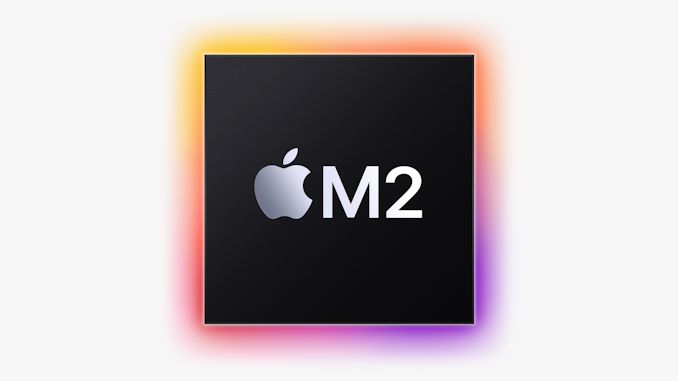
Though primarily a software-focused event, Apple’s WWDC keynotes are often stage for an interesting hardware announcement or two as well, and this year Apple did not disappoint. At the company’s biggest Mac-related keynote of the year, Apple unveiled the M2, their second-generation Apple Silicon SoC for the Mac (and iPad) platform. Touting modest performance gains over the original M1 SoC of around 18% for multithreaded CPU workloads and 35% in peak GPU workloads, the M2 is Apple’s first chance to iterate on their Mac SoC to incorporate updated technologies, as well as to refresh their lower-tier laptops in the face of recent updates from their competitors.
With the king of the M1 SoCs, M1 Ultra, not even 3 months behind them, Apple hasn’t wasted any time in preparing their second generation of Apple Silicon SoCs. To that end, the company has prepared what is the first (and undoubtedly not the last) of a new family of SoCs with the Apple Silicon M2. Designed to replace the M1 within Apple’s product lineup, the M2 SoC is being initially rolled out in refreshes of the 13-inch MacBook Pro, as well as the MacBook Air – which is getting a pretty hefty redesign of its own in the process.
The launch of the M2 also gives us our first real glimpse into how Apple is going to handle updates within the Apple Silicon ecosystem. With the iPhone family, Apple has kept to a yearly cadence for A-series SoC updates; conversely, the traditional PC ecosystem is on something closer to a 2-year cadence as of late. M2 seems to split this down the middle, coming about a year and a half after the original M1 – though in terms of architecture it looks closer to a yearly A-series SoC update.
From a high level, there has been a limited number of changes with the M2 – or at least as much as Apple wants to disclose at this time – with the focus being on a few critical areas, versus the bonanza that was the initial M1 SoC. While all of this is preliminary ahead of either further disclosures from Apple or getting hands-on time with the hardware itself, the M2 looks a lot like a derivate of the A15 SoC, similar to how the M1 was derived from A14. As a result, at first glance the M1 to M2 upgrade looks quite similar to the A14 to A15 upgrade.
According to Apple, the new SoC is comprised of roughly 20 billion transistors, which is 4B (25%) more than the original M1 – and 5B more than the A15 SoC. The chip is being made on what Apple terms a “second generation 5nm” process, which we believe is likely TSMC’s N5P line, the same line used for the A15 SoC. N5P offers improved performance characteristics versus N5, but not density improvements. So while Apple doesn’t disclose die sizes, the company’s side-by-side die shots are at least accurate in that M2 is going to be a bigger chip than M1.
| Apple Silicon SoCs | |||
| SoC | M2 | M1 | |
| CPU | 4x High Performance (Avalanche?) 16MB Shared L2 4x High Efficiency (Blizzard?) 4MB Shared L2 |
4x High Performance (Firestorm) 12MB Shared L2 4x High Efficiency (Icestorm) 4MB Shared L2 |
|
| GPU | "Next Generation" 10-Core 3.6 TFLOPS |
8-Core 2.6 TFLOPS |
|
| Neural Engine | 16-Core 15.8 TOPS |
16-Core 11 TOPS |
|
| Memory Controller |
LPDDR5-6400 8x 16-bit CH 100GB/sec Total Bandwidth (Unified) |
LPDDR4-4266 8x 16 CH 68GB/sec Total Bandwidth (Unified) |
|
| Memory Capacity | 24GB | 16GB | |
| Encode/ Decode |
8K H.264, H.265, ProRes, ProRes RAW |
4K H.264, H.265 |
|
| USB | USB4/Thunderbolt 3 2x Ports |
USB4/Thunderbolt 3 2x Ports |
|
| Transistors | 20 Billion | 16 Billion | |
| Mfc. Process | "Second Generation 5nm" TSMC N5P? |
TSMC N5 | |
Starting from the top, in terms of their Arm-architecture CPU cores, the M2 retains Apple’s 4 performance plus 4 efficiency core configuration. Apple is not disclosing what generation CPU cores they’re using here, but based on the performance expectations and timing, there’s every reason to believe that these are the Avalanche and Blizzard cores that were first introduced on the A15.
With regards to performance, Apple is saying that the M2 offers 18% improved multi-threaded CPU performance versus the M1. The company does not offer a breakdown of clockspeeds versus IPC gains, but if our hunch about M2 being Avalanche/Blizzard is correct, then we already have a good idea of what the breakdown is. Relative to the Firestorm core in the A14/M1, Avalanche offers only modest performance gains, as Apple invested most of their improvements into improving overall energy efficiency. As a result, the bulk of the performance gains there come from increased clockspeeds rather than IPC improvements.
The performance CPU cores on M2 also come with a larger pool of L2 cache, which also serves to improve performance. Whereas M1 had 12MB of L2 cache shared among the cores, M2 brings this up to 16MB, a 4MB increase over both the M1 and for that matter the A15.
Based on what we’ve already seen with the A15, this bigger update in this generation is on the efficiency core side of matters. The Blizzard CPU cores are increasingly behaving like not-so-little cores, offering relatively high performance and a much wider backend design than what we see with other Arm efficiency cores. Among other things, Blizzard added a fourth Integer ALU, which combined with other changes gave A15 a significant (28%) performance increase in those cores. Carried over to M2, and it’s not unreasonable to expect similar gains, though the wildcard factor will be what clockspeeds Apple dials things to.
This, in turn, is also seemingly why Apple has decided to focus on MT performance for their Apple-to-Apple comparison. With the largest performance gains coming courtesy of the efficiency cores, in performance-bound situations it’s MT workloads which get to tap the E cores alongside the P cores that would see the greatest performance improvements. On the whole, Avalanche/Blizzard made for a modest year on the CPU microarchitecture front, and that looks to be carrying over for the M2 SoC.
Meanwhile on the GPU front, Apple is going bigger. Though reclusive as always about the underlying architecture – merely calling this a “next generation” GPU – M2 comes with 10 GPU cores baked in, up from 8 on the M1. Officially, this GPU is rated for 3.6 TFLOPS, which is a 1 TFLOPS more than the 8 core M1. As well, the new GPU comes with a larger shared L2 cache, though Apple isn’t disclosing the cache size there.
With a combination of a larger core count and what would seem to be a 10% or so increase in GPU clockspeeds (based on TFLOPS), Apple is touting two performance figures for the M2’s GPU. At iso-power (~12W), the M2 should deliver 25% faster GPU performance than the M1. However the M2’s GPU can, for better or worse, also draw more power than the M1’s GPU. At its full power state of 15 Watts, according to Apple is can deliver 35% more performance.
Overall this indicates that while Apple has been able to improve their energy efficiency – GPUs love running wide and slow – Apple’s peak GPU power consumption is going up. This should have minimal impact on light workloads, but it will be interesting to see what it means for relatively heavy and constant workloads, especially on the fanless MacBook Air. Meanwhile the GPU’s display controller remains seemingly unchanged, topping out at 6K for external monitors.
Tangential to the GPU updates, M2 also comes with an updated video encode/decode block, which at first glance looks a lot like a pared-down version of the block used on the M1 Pro/Max. Those SoCs added support for Apple’s ProRes and ProRes RAW codecs, and that support has now filtered back down into the base M2 SoC. As well, Apple is now officially supporting 8K video decode on the M2, whereas the M1, though never having an official resolution designation, was essentially a 4K part.
Finally, on the processing side of matters, the M2 is inheriting the A15’s updated neural engine. According to Apple, this is still a 16-core design, and it happens to have the same 15.8 trillion operations per second (TOPS) rating as the A15’s neural engine. Which, despite only being on par with the A15, still makes it 40% faster than the M1’s neural engine, which topped out at 11 TOPS.
Altogether, Apple is projecting a great deal of confidence in the performance of their second-generation Apple Silicon chip, and even more so its competitiveness versus Intel. While we’ll have to wait to get our hands on the hardware to confirm its performance, the M1 certainly lived up to claims there. So the expectations for M2 are similarly high.
Memory: LPDDR5-6400, Up To 24GB
While the core logic of Apple’s latest SoC would seem to be largely an enhanced version of the A15, it does have one very notable feature advantage: LPDDR5 support.
Whereas the vanilla M1 (and the A15) only supported LPDDR4x memory, the M2 supports the newer LPDDR5 memory standard. The biggest change of which is support for much higher memory clockspeeds; based on Apple’s figures, the M2 is running at 6400Mbps/pin (LPDDR5-6400), which is up significantly from the 4266Mbps/pin (LPDDR4x-4266) memory clockspeeds of the original M1. The net result is that, on the SoC’s 128-bit memory bus, the M2 has 100GB/second of memory bandwidth to play with, a 50% increase over the M1 (~68GB/sec).
Apple’s unconventional use of memory technologies remains one of their key advantages versus their competitors in the laptop space, so a significant increase in memory bandwidth helps Apple to keep that position. Improvements in memory bandwidth further improve every aspect of the SoC, and that especially goes for GPU performance, where memory bandwidth is often a bottlenecking factor, making the addition of LPDDR5 a key enabler for the larger, 10-core GPU. Though in this case, it's the M2 playing catch-up in a sense: the M1 Pro/Max/Ultra all shipped with LPDDR5 support first, the M2 is actually the final M-series chip/tier to get the newer memory.
Past that, Apple is once again placing their LPDDR5 memory packages on-chip with the processor die itself. So each M2 chip will need to be equipped with memory ahead of time, and the device supply is likely to fluctuate a bit based on memory capacity depending on what the most popular configurations are, especially early on.
M2 devices are available with either, 8GB, 16GB, or 24GB of memory. Given that Apple is still using just two stacks of memory, it looks like the company is finally taking advantage of LPDDR’s support for non-power-of-two die sizes (e.g. 12Gb dies), which allows them to get 12GB of memory into a single package without any further shenanigans. And assuming Apple replicates this down the line for the obligatory Pro/Max/Ultra SoCs, we should see the top memory capacities of all of Apple’s SoCs increase by 50% over the previous generation.
And the Rest: Updated ISP, Same USB
Rounding out today’s M2 announcement, there are a couple more items that warrant a quick call-out.
First, the M2 is getting an updated ISP as well as an updated Secure Enclave. Like other aspects of M2, these are likely inherited from the A15, which received similar updates as well.
Meanwhile, a look at the specs of the new MBA and MBP indicate that there haven’t been any notable changes in USB or other I/O support for the new SoC. M1 was already at the top of the curve in 2020 when it launched with USB4 support, so nothing has changed here. This does mean, however, that the SoC is seemingly still limited to Thunderbolt 3 support, despite the fact that Thunderbolt 4 has now been out for well over a year. Both the MBA and MBP are also shipping with two USB ports, so it would seem that’s still the native limit of the SoC.
Apple also hasn’t talked at all about PCIe capabilities. We’ll know more once we have the hardware in-hand, but at least for now there’s no reason to believe that Apple has added PCIe 5 support or changed the number of lanes available. I/O has remained something of a constraining factor for the entire Apple Silicon family, so it does make me wonder about what this means for the eventual Apple Silicon Mac Pro.
Available in July
Closing out today’s announcement, the M2 will be shipping in the new 2022 MacBook Air, as well as the refresh 2022 12-inch MacBook Pro. According to Apple, those devices will be available in July, with pre-orders open today.
In the meantime, the M1 isn’t going anywhere. Besides being at the heart of the Mac Mini – which didn’t receive an update today – Apple is keeping the 2020 M1-based MacBook Air around. So both versions of the entry-level M-series SoC will be sticking around for some time to come.



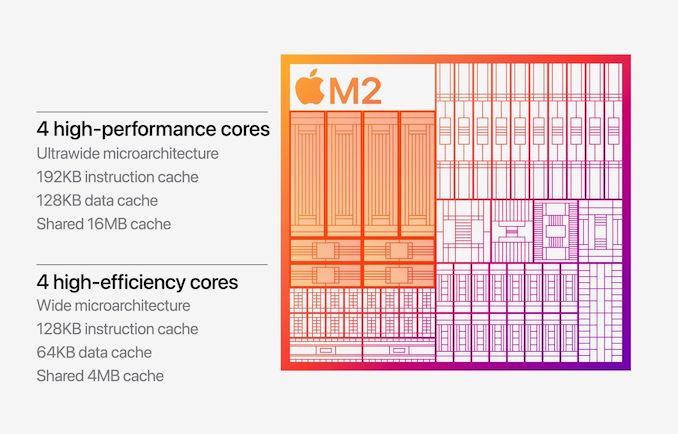
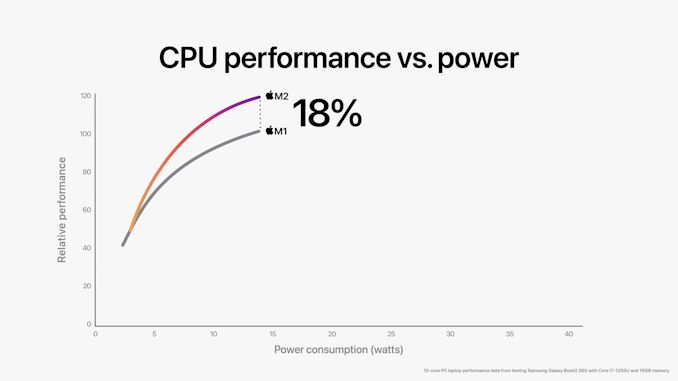
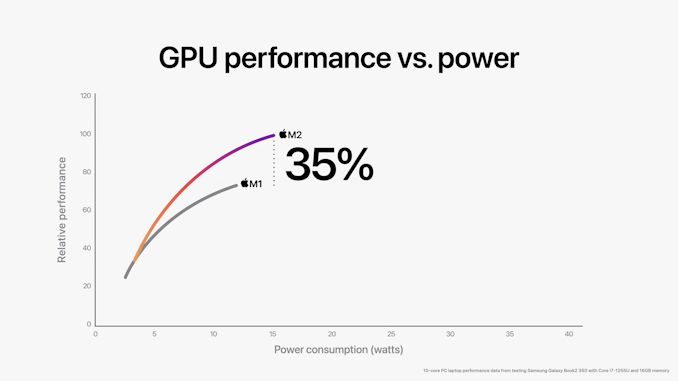
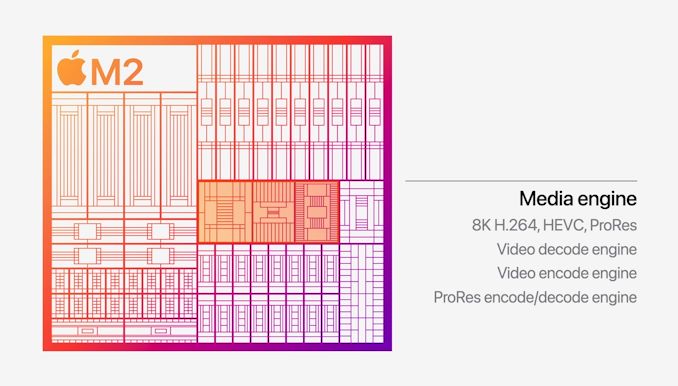
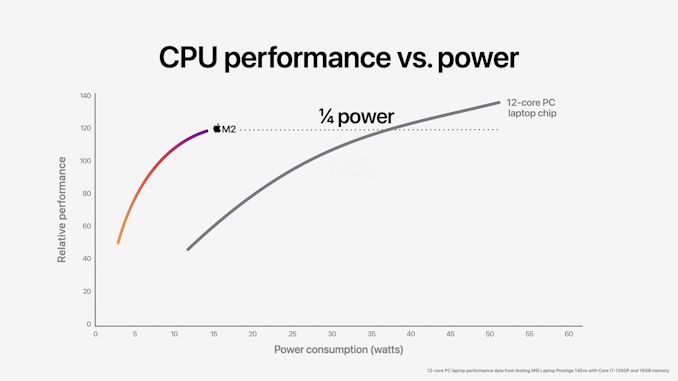
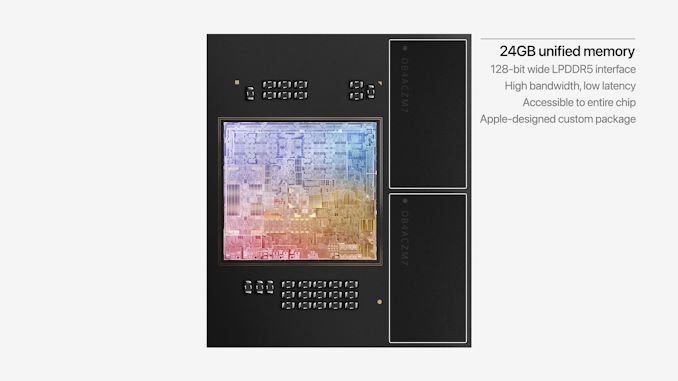

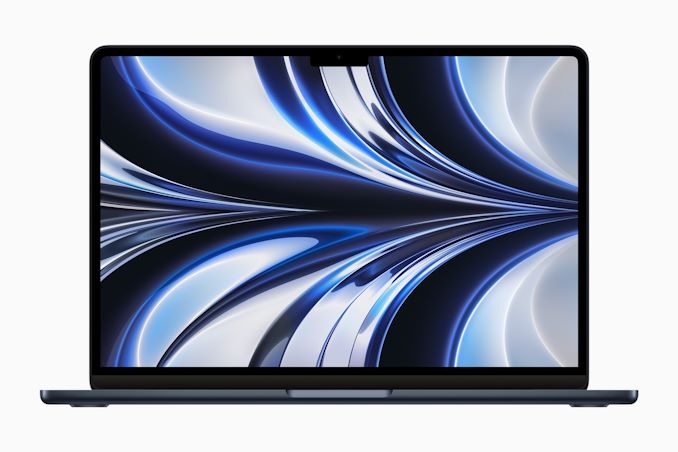








171 Comments
View All Comments
Tom_Yum - Monday, June 6, 2022 - link
I think the mismatch between M1 Graphics compute performance versus gaming performance comes down largely to software (both MacOS and actual games) more than the underlying hardware. Few developers organically develop for Metal (more often they get other developers to port the game across to Metal for them, which is never as efficient as developing from day 1 for Metal support), and the degree of optimisation for Metal comes down to the skill of the developer and how much effort they deem worth investing to target a pretty small market. There is also the question of how well optimised MacOS itself is for the needs of gaming, such as low-latency input management. It has never been a priority for Apple, who have largely targeted the creator market that doesn't really benefit from those things.Personally, I think Apple is going to need to take a leaf from nVidia's book and bankroll a bunch of developers to develop Metal optimised versions of popular games, and through that try to nurture MacOS gaming as a viable, worthwhile target for all gaming developers. Until they do, most developers will continue to ignore MacOS or treat it as a porting afterthought with only just enough time put into it to make it run but not enough to make it well optimised. At present, the main way MacOS users play games is through Parallels or CrossOver, which doesn't help address the situation because it further disincentivises developers to develop decent MacOS ports.
Basically, Apple could make a RTX3090Ti-equivalent GPU, but it would still game poorly if every game is gimped by poor Metal optimisation or running through a clunky Vulkan to Metal translation layer.
name99 - Monday, June 6, 2022 - link
You assume Apple is interested in pursuing the "hard core/console" gamer market.I see no evidence for this, now or ever.
Apple is interested in the reverse issue of "make the mac experience richer for people who are already mac fans", but they have zero interest in "converting" non mac fans, especially the sort who rant on the internet about how much Apple sucks...
Scalarscience - Monday, June 6, 2022 - link
I agree with this, with the caveat that they also do a great job of appealing to extremely casual gamers/mobile gamers/children using Apple devices. They would clearly eyeball this as a potential future market and track it to see if is worth investing more in, as evidenced by them already moving the Apple TV platform further into their gaming ecosystem.Of course all companies would be eyeballing crossover mobile users now, so you could classify it easily with your comment under these people already being 'mac fans'.
Abe Dillon - Thursday, June 9, 2022 - link
I agree that they seem to have little interest in targeting "gamers". It's a low profit market with lots of entrenched competitors.What I don't get is why you think they should target the people "who rant on the internet about how much Apple sucks". Trying to "convert" people who never matured past a grade-school mentality of brand tribalism is a complete waste of time. They're impervious to reason.
Example: This thread was started by someone who actually believes the M1 Ultra's 64-core GPU is outranked by an RTX 3050. I don't know where they're getting that info, but it's pretty silly.
Tom_Yum - Tuesday, June 7, 2022 - link
I didn't see any ranting about how much Apple sucks in my post. While I agree that Apple isn't interested in going after the 'hard core gamer' market, I strongly doubt that Apple don't see business benefits from broadening the appeal of their Macintosh line beyond current 'mac fans', given the Mac also serves as a gateway into the broader Apple ecosystem. The hardware is capable of gaming, but the software is lacking.There are many people out there that would love to buy a Mac but also occasionally play games. Most people are generalists who want something that can do everything ok (think about how popular SUVs are now, even if they are rarely used offroad). Do you think the Mac's market share wouldn't increase significantly if it could provide all the performance it does, all the battery life it does, and could also reliably run the majority of AAA titles? Do you really think Apple isn't interested in increasing MacOS's marketshare? Sell a great laptop, and then next time that person buys a phone suddenly that iPhone has a lot more value add, suddenly Apple Music subscription seems like a better deal, etc. Before you know it, that individual who sat outside the Apple ecosystem is fully embedded. Or they can continue to target only 'mac fans' who are already in the ecosystem....
name99 - Tuesday, June 7, 2022 - link
(a) Go read a site like phoronix. No matter WHAT Apple does, it's not good enough and is interpreted in the worst possible way.(b) Remember this?
https://www.escapistmagazine.com/john-romero-apolo...
Apple does not want to be associated with that culture. And sure, so OK, 20 years on Romero grew up. Problem is, there is a constant stream of new teenagers with the exact same mentality to take his place.
(c) What do you want Apple to do? What developers say they want is Apple devices that look exactly like PCs. They want x86, and they want DX or Vulkan. Apple isn't going to give them either of those (for the very simple reason that they're not going to destroy their long term goals to gain 5% extra sales this year).
That's my point -- gamer whining is not rational, actionable whining. It is not a list of realistic things that Apple could do, it's whining for the sake of whining.
For example, something Apple has just added as part of Metal3 is a technical call to get the base address of the GPU. This apparently will make Vulkan much more performant. But notice -- no gaming whiner was asking "provide this API call", something realistic and actionable. It was all "Apple sucks and they cost too much and they should be using Vulkan because it's a million times better than Metal, and I would never buy a Mac even if you paid me"...
mode_13h - Saturday, June 11, 2022 - link
> no gaming whiner was asking "provide this API call", something realistic and actionable.If you want to know what actual game *developers* think of Apple, you might be looking in the wrong places. There's a lot of noise on the internet that can easily drown out whatever signal you're seeking, if you don't filter it carefully.
mode_13h - Saturday, June 11, 2022 - link
> Go read a site like phoronix. No matter WHAT Apple does, it's not good enough> and is interpreted in the worst possible way.
Phoronix is specifically focused on Linux and open source. Apple is famously secretive, prefers proprietary standards, practically invented walled gardens in computing, and caters towards less technical users. You basically couldn't find an audience more hostile to Apple, if you tried. To cite them as characteristic of some general reception towards Apple is either seriously misguided or disingenuous.
magreen - Wednesday, June 8, 2022 - link
Your posts are eminently reasonable and thoughtful. Perhaps that's why they garner such a strong reaction.Abe Dillon - Thursday, June 9, 2022 - link
"There are many people out there that would love to buy a Mac but also occasionally play games."There are tons of options for those people. Get a mac and a cheap PC or a Console.
"Most people are generalists who want something that can do everything ok"
Most people **aren't** hard core gamers who care about hitting 60 fps on max settings.
Most hard core gamers think everyone is a hard core gamer. There are plenty of people who just want to play a bit of Stardew Valley or The Sims or Minecraft and they're perfectly happy doing it on an old PS 4.
"Do you really think Apple isn't interested in increasing MacOS's marketshare?"
Yes. I do. Apple puts profit margin ahead of market size. If the market is huge, but the profits are razor thin, then you're dancing on a thin line between success and bankruptcy. It only takes small fluctuations in component prices for your margin to go negative and sink the ship. Game machines are notoriously a low-margin business. Apple has no interest in that.
"Sell a great laptop, and then next time that person buys a phone suddenly that iPhone has a lot more value add"
The halo effect cuts both ways: enter a low-margin market and you'll have to compromise on quality to compete, then it tarnishes the whole brand.
"Or they can continue to target only 'mac fans' who are already in the ecosystem."
It's rather self-centered to assume that Apple's only play is to cater to hard-core gamers or 'mac fans'. There couldn't possibly be other markets for Apple than the "coveted" gamer market, right? They just dropped a machine that can encode/decode 18 streams of 8K video simultaneously. Do you think they did that for shits and giggles? Don't you think they **might** be targeting some sort of market with that capability? <<rolls eyes>>